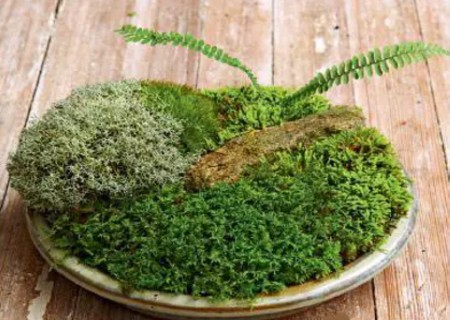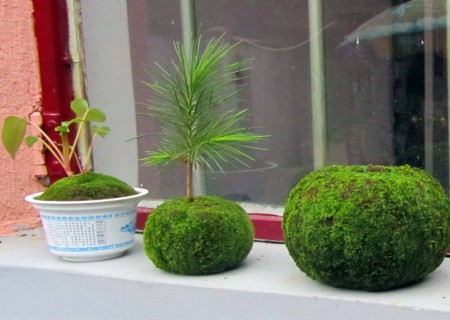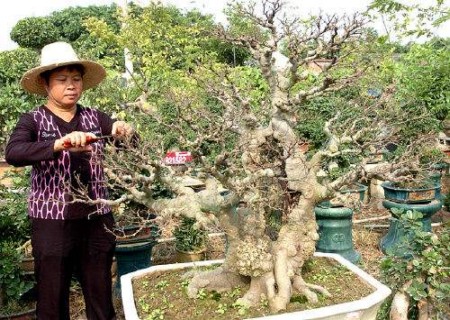How to make moss bonsai
Bryophytes like dark and humid environment, generally grow on exposed stone walls, or wet forests and swamps, have indomitable vitality. Moss is a good substrate for bonsai. Bryophytes belong to the lowest plant, flowerless, seedless, and reproduce by spores. Their structure is simple, including only stems and leaves, and sometimes only flattened foliage, without real roots and vascular bundles. With a fresh green moss and traditional indoor potted plants, a variety of innovative bonsai can be designed, and the green moss is pleasing to the eye.

Moss bonsai is a common form of bonsai, which is loved by everyone because of its high ornamental quality and low cost. "the moss marks are green on the steps, and the grass is green in the curtain." This is the beauty of artistic conception brought by moss. Transplanting moss into glass or tile utensils, supplemented by decoration, forms a micro world, which adds a lot of quiet sense to the space and is full of Zen. So, how should moss bonsai be made?
Busy life, if there is a touch of green to moisten your eyes, it will be how comfortable and tranquil. So, let's take a look at how Xiaobian's moss bonsai is made.
1. Drilling drainage holes
Drill a drain hole in the center of the plate with a porcelain drill and cover the bottom of the plate with enough water to prevent dust during drilling and cool the drill. Drill in at an angle of 45 degrees to create a groove as a cut-in point to stabilize the bit. Lift the drill bit slowly, wash the dishes with water, continue drilling, and repeat the process until it is done.
2. Add substrates
Put a layer of gardening landscape cloth on the bottom of the plate to prevent pebbles and culture soil from blocking the drainage hole and add a thin layer of pebbles that help to drain the water.
3. Fill the plate
Fill the well-drained culture soil, not higher than the edge of the plate. To construct the main frame for the bonsai, we used a stone and a black handle fern to dig a hole with a spoon to plant vascular plants. Moss and lichens are laid on the cultivated soil and compacted, and the design elements are added in the order from large to small.
4. Prune the moss
Cut off a piece of moss that is slightly larger than the area to be laid, and carefully trim it with pliers to make it slightly larger than needed to tuck in the edge of the moss.
5. Stuffed with moss
You can use any handy tool to plug the moss, here we use bamboo cuttings, and then use tweezers or medical clamps to remove leaf debris. The last moss used are moss, curly-tailed moss, reindeer moss and black-stalked fern.
Production items of moss bonsai:
1. Choose a container for your moss bonsai, but do not use a metal container, as moss is very sensitive to metals and chemicals.
2. The top filler uses soil, and unless you also plant vascular plants, the shallow layer of the top layer is the part you want to fill, that is, the soil.
3. Purchase moss from flower market or online store.
4. when collecting moss, use a small shovel or spatula to lift the soil from under the moss, bring a thin layer of soil under the moss, take as much as you use each time, and you don't have to dig too much at one time.
5. Try different moss combinations. If a single species of moss does not grow well, restore it to the collection site to repair, or replace it with well-developed moss varieties.
6. water the finished moss bonsai and press down to make close contact between the moss.
In addition, the following technical points should be mastered:
1. Watering for moss, in addition to replenishing water, can also take away the waste material stored in the soil and make the soil cleaner. All plants have the same principle: water thoroughly every time they are watered, and moss is no exception. Excess water will be discharged from the drain. Therefore, the utensils used for moss bonsai had better have leaks, and if it is glassware, it is best to put some small stones or shells in the container. Stagnant water can affect the health of moss. Water the moss and choose the right time. Early in the morning is better, do not water in the higher temperature of the sun. As for when to water, it can be decided by observing the growth state of the moss, mainly to observe whether the "buds" of the moss are full, whether there are new buds, and whether the color is too yellow.
2. The environment suitable for moss growth is very similar to that suitable for human settlements: stable climate, certain humidity, ventilation and moderate light. Its best living environment is outdoor or close to the outdoor environment, preferably to the southeast half-cloudy and half-sunny place.
3. Early morning dew and faint sunlight are the favorites of moss. Many people think that moss likes dark and humid environments, but this view is not true. If you want the moss to grow well, you must give it a certain amount of sunlight, but it is better to use faint scattered light rather than direct sunlight, for example, to allow the moss to enjoy sunbathing in the early morning.
4. Moss is very different from other plants. First, its roots basically only play the role of climbing and fixing plants, mainly relying on leaves to absorb water and thin nutrients in the air. Second, if the air humidity is not enough, it will automatically enter the dormant state. At this point, the color will turn gray-green, but this does not mean that the moss is "dead". In fact, the dormant moss is very strong, not afraid of cold and heat, can withstand for several months, once exposed to moisture, it will appear green.
5. The cultivation of moss does not need special soil, the general soil can survive, and does not need special fertilization. Indoor viewing should be placed in a ventilated and bright position. Ventilation must be ensured, but the wind speed should not be too high. In addition to the green meaning of the plant itself, you can also choose some green flower utensils to dye the spring. The effect of an eyeful of green is sometimes amazing.
Remember that moss is most afraid of sauna-like heat and humidity.
7. Daily maintenance would rather be dry than too wet. Naturally dry dormant moss can recover after soaking in water, but moss that is wet for a long time can be easily damaged if the temperature is not adjusted properly.
Maintenance notes:
1. The environment suitable for moss growth is very similar to that suitable for human settlements: maintaining a certain degree of humidity, ventilation and moderate light.
2. Bryophytes are not suitable to grow in the dark, they need some scattered light or semi-shady environment. During maintenance, a certain amount of light should be given, preferably weak scattered light rather than direct strong sunlight.
3, spray water many times a day, do not pour too much water at a time, just keep the moss moist. The best growth temperature of moss jade is about 25 ℃ and should be placed indoors in winter.
4. Moss is very different from other plants. First, its roots basically only play the role of climbing and fixing plants, mainly relying on leaves to absorb water and thin nutrients in the air. Second, if the air humidity is not enough, it will automatically enter the dormant state. At this point, the color will turn gray-green, but this does not mean that the moss is "dead". In fact, the dormant moss is very strong, not afraid of cold and heat, can withstand for several months, once exposed to moisture, it will appear green.
Time: 2019-05-26 Click:
- Prev

Diagram of self-made method of DIY for bonsai with moss jade balls
Moss jade, fresh and elegant, evergreen all the year round, is more ornamental than meat. At present, it is very popular in Europe, the United States, Japan and South Korea. Moss jade is not only a kind of plant, but also a kind of planting method, an ancient Japanese art evolved from bonsai, which began in the Edo period of Japan and belongs to a kind of Japanese bonsai.
- Next

The method of making Pushu bonsai
Park Shumeng has a strong hair force and is easy to take root, and most of the ancient stumps are excavated from the wild. Most of the southern regions choose 23 months of mining, when the temperature rises, the humidity is high, and the excavated trees are not easy to be air-dried and easy to survive. When digging, we should choose stumps with old, good tree shape, dwarf trunk and natural curved trunk.
Related
- Fuxing push coffee new agricultural production and marketing class: lack of small-scale processing plants
- Jujube rice field leisure farm deep ploughing Yilan for five years to create a space for organic food and play
- Nongyu Farm-A trial of organic papaya for brave women with advanced technology
- Four points for attention in the prevention and control of diseases and insect pests of edible fungi
- How to add nutrient solution to Edible Fungi
- Is there any good way to control edible fungus mites?
- Open Inoculation Technology of Edible Fungi
- Is there any clever way to use fertilizer for edible fungus in winter?
- What agents are used to kill the pathogens of edible fungi in the mushroom shed?
- Rapid drying of Edible Fungi

